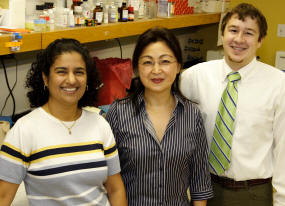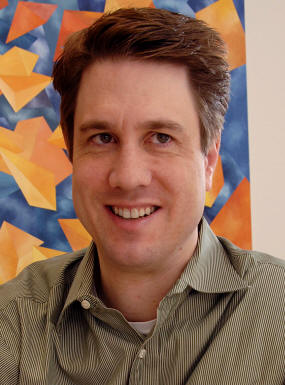2011 Biomedical
Research Collaboration Award
Memphis, TN, June 05, 2011 -- The Hartwell
Foundation officially announced the winners of its
fourth Biomedical
Research Collaboration Award to provide funding to
expand the frontiers of early-stage, innovative, and
cutting-edge applied biomedical research through special
collaboration. 2007 Hartwell Investigator
Anjali M.
Rajadhyaksha, Ph.D., Assistant Professor of
Pediatrics and Neuroscience, Weill Cornell Medical
College of Cornell University, together with 2006 Hartwell Investigator
Andrew A.
Pieper, MD, Ph.D., Assistant Professor of Psychiatry
and Biochemistry, UT Southwestern Medical Center, will
receive $431,684 in combined direct cost over three
years to pursue their proposed research for
"Pharmacologic Agents for Treatment of Anxiety in
Autism: Cav1.2-deficient Mice as a New Animal Model of
Autism". Dr. Pieper was a previous recipient of a
Hartwell Collaboration Award in 2008. Both Cornell and
UT Southwestern were recently named to
The Hartwell Foundationís
2011 Top Ten Centers of Biomedical Research.
One of the primary reasons for the absence of effective
pharmacologic treatments for autism is the complete lack
of animal models that faithfully replicate
autism-associated anxiety, one of the most salient
features of this childhood neurological disease.
Recently, however, Dr. Rajadhyaksha serendipitously
discovered unique manifestations of anxiety in mice
genetically engineered to lack the Cav1.2 gene. The mice
exhibit anxiety-like behaviors using three separate
mouse behavioral assays, with no manifestation of
compulsive repetitive behaviors. Affected mice display
impaired social interaction and a prominent state of
high anxiety reminiscent of the behavior in autistic
children. Importantly, mutations in this gene are also
known to be present in some children affected with
autism.
As a 2007 Hartwell Investigator, Dr. Rajadhyaksha
proposed combining human genetic studies with mouse
models to understand the biological basis of what causes
autism, with the ultimate goal of developing medications
to treat autistic children. She was particularly
interested in the biochemical and functional
consequences of mutated genes that cause aberrant
neuronal calcium (Ca2+) signaling. Such altered
signaling could affect synaptic transmission and disrupt
communication between nerve cells, which could contribute to abnormal brain
development. Anjali proposed that perturbations in the
developmental regulation of the Cav-BKca channel complex
responsible for controlling the movement of calcium ions
probably converge in some final common pathway to
produce a subset of disorders known to be associated
with autism.
As a 2006 Hartwell Investigator, Dr. Pieper proposed an
innovative whole animal model for discovery of small
molecules having neurogenic efficacy for treatment of
childhood schizophrenia. Unlike conventional drug
screens, which deploy binding or cell based assays in
vitro, he successfully demonstrated how to identify
compounds that were both pharmacologically active and
non-toxic in living animals, quickly elevating promising
candidates for new drugs to a very early stage of
development. Screening in vivo not only provides an
opportunity for accurate and reproducible assessment of
the corrective effects of small molecules being screened
on the phenotype, but also provides information about
how effectively the drugs are tolerated by living mice.
In Andrew's search to identify a drug that would ameliorate the
phenotype in his mouse model of
schizophrenia, he discovered 8 potent, non-toxic,
small drug-like molecules that stimulated neurogenesis
in the hippocampus. The most
promising compound could be administered orally to mice,
had a blood circulation half life of approximately 6-7
hours and crossed both the blood brain and placental
barriers. Administration of this compound to a mouse
model of schizophrenia completely corrected morphologic
abnormalities in the structure of the hippocampus. This
effect correlated with restoration of normal
electrophysiologic circuitry within the hippocampus,
which is important in learning and memory. Dr. Pieperís
discovery thus holds great promise for the development
of new pharmacologic agents that might improve
hippocampal structure and function in schizophrenia and
other related conditions.
Previously, in 2008, Andrew shared the first Hartwell
Collaboration Award along with 2006 Hartwell
Investigator,
Guoping
Feng, Ph.D., from Duke University for "Rapid
Discovery of Small Molecules for Drug Development in an
Animal Model of Obsessive-Compulsive Disorder." They
proposed using Fengís unique mouse model of
obsessive-compulsive disorder together with the
unconventional and technically demanding whole animal
approach developed and successfully deployed earlier, by
Pieper. Recently, Pieper and Feng obtained promising results
that suggest they may have identified a novel
pharmacologic agent to treat the compulsive repetitive
grooming phenotype. To date, Andrew has also
independently used his biologic screening approach in an
animal model of Rett syndrome to successfully discover
new compounds that may lead to the development of novel
pharmacologic approaches to treating this
autism-spectrum disorder as well.
Together, Drs. Rajadhyaksha and Pieper will collaborate
to utilize the innovative drug discovery approach
developed by Pieper for the unique Cav1.2 mouse model of
autism-associated anxiety described by Rajadhyaksha.
They seek to behaviorally and neuroanatomically
characterize this unique anxiety phenotype as a model of
autism, and to apply screening in vivo to identify novel
compounds that will ameliorate anxiety in these mice.
Their hope is that this will form the basis for the
development of new drugs to treat anxiety in children
with autism. Once an efficacious small drug-like
molecule is identified, they intend to work closely with synthetic
organic chemists in the UTSWMC Department of
Biochemistry to synthesize and screen new chemical
variants to improve biologic efficacy, while
simultaneously conferring a more favorable profile of
adverse off-target activity. Other substances based on
the initial chemical structures can then be synthesized
to help discern the mechanism of action of the newly
discovered molecule, which will also contribute to
understanding the underlying disease process.
The Rajadhyaksha-Pieper collaboration brings together
new opportunities conveyed by a unique mouse model of
anxiety in autism with an innovative, technically
sophisticated, cutting edge approach to drug discovery.
"Since anxiety cannot be recapitulated in a cell or a
test tube, it must be modeled in intact living animals.
My unique mouse model appears to represent for the first
time a genetic model of autism that replicates
autism-associated anxiety," said Dr. Rajadhyaksha.
"The importance of characterizing these mice in order to
gain valuable insights into the autism disease process
can not be underestimated. This animal model could provide an unprecedented
opportunity to discover new drugs for treating the
debilitating anxiety associated with autism in
children," related Dr. Pieper.
Fostering collaborations between investigators of
complementary scientific strengths is one of the
objectives of The Hartwell
Foundation Mission to fund innovative, early-stage
applied biomedical research with the potential to
benefit children.
|
|

2007 Hartwell Investigator
Anjali Rajadhyaksha, Ph.D.,
Weill Cornell Medical
College of Cornell University

2006 Hartwell Investigator
Andrew Pieper, MD, Ph.D., University of Texas
Southwestern Medical Center
Biomedical Research Collaboration Awards
Individual Biomedical
Research Awards
Top Ten Centers
HOME
|

